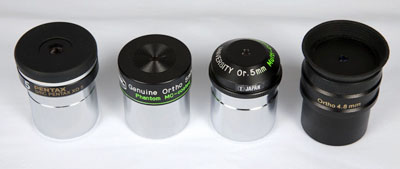
Figure 1 (From left to right): Pentax 5mm XO; Baader Planetarium 5mm Genuine Orthoscopic; University Optics 5mm Abbe Orthoscopic ; University Optics 4.8mm Super Abbe Orthoscopic
Four 5mm eyepieces that are readily available from US astronomy equipment suppliers were evaluated and reviewed for their performance in planetary observing with 4 and 5 inch refractor telescopes. Going into the tests, I assumed that the orthoscopic eyepieces would provide excellent on axis viewing of planetary detail based on a wide array of reviews on this classic simple eyepiece design.
The main questions I was interested in addressing in the tests were:
 |
Figure 1 (From left to right): Pentax 5mm XO; Baader Planetarium 5mm Genuine Orthoscopic; University Optics 5mm Abbe Orthoscopic ; University Optics 4.8mm Super Abbe Orthoscopic |
5mm Eyepieces Evaluated/ Reviewed
Other eyepieces were used in the tests with the 5mm eyepieces including: Televue 3.5mm Nagler type 6, University Optics 4mm Abbe Orthoscopic, University Optics 7mm Abbe orthoscopic and Televue 7mm Nagler type 6. In addition, I compared performance of the 5mm eyepieces with quality of viewing through a binoviewer (William Optics binoviewer with Televue 8mm Plossl eyepieces and 1.6X Barlow nosepiece lens or with 5mm University Optic Abbe Orthoscopic eyepieces and no nosepiece lens).
Refractors Used for Evaluations
Evaluation procedures
Jupiter and Saturn were observed during early morning and evening periods between June 29 and July 30, 2011 from Gainesville Florida. Conditions were very humid and sky transparency was low. However, seeing was generally good to excellent. Saturn in early evening was occasionally observed under only fair seeing conditions after rain storms passed through. Observations were made with 2 to 3 telescope at a time using all four 5mm eyepieces switching between telescopes mounted on Losmandy G11 and GM-8 equatorial mounts. At each time period, all four eyepieces were switched between the three telescopes being tested at that time using the same diagonal (usually a 2-inch Astro-Physics Max Bright). Image sharpness, color saturation and contrast and light scatter pattern (glare around point light source) were compared.
Note on light scatter patterns: Light scatter was estimated by comparing the outer border of the glare around Jupiter or Saturn relative to a bright outer moon (e.g., Titan for Saturn and usually Io for Jupiter). The amount of perceived light scatter around a bright planet is the result of several variable factors including: 1) scatter of reflected light from the planet in Earth's atmosphere due to atmospheric moisture and particulates; 2) telescopic front element and tube internal reflections and scatter; 3) diagonal reflectivity and scatter; and 3) eyepiece scatter and internal reflections. When generating the light scatter patterns for the four eyepieces, they were done in a period of a few minutes using the same telescope and diagonal so that all factors except the eyepiece were as constant as possible.
Results
Three of the four 5mm eyepieces tested provided sharp planetary views at the 163 to 200X magnification viewing with the four refractors. The Pentax XO, Baader ortho and UO ortho provided sharper, more detailed planetary than any of the other eyepieces tested. Seeing was generally not good enough to get optimal views with either the 4mm UO orthoscopic or 3.5mm Televue Nagler type 6. Very sharp views of Jupiter and Saturn were obtained with the 7mm UO orthoscopic and 7mm Televue Nagler type 6. However, the 5mm eyepieces provided more planetary detail.
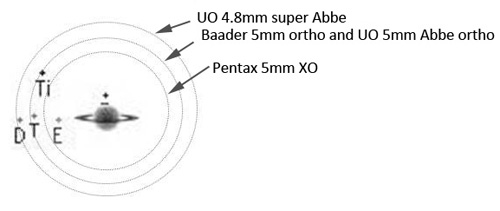 |
Figure 2: Visible light scatter pattern for 5mm eyepieces viewing Saturn
with TSA-102 on July 30, 2011 at about 1:00 UT |
|---|
Binoviewer performance compared to single eyepiece viewing: The binoviewer allowed viewing using binocular vision for detection of subtler cloud surface details and tonal changes that were especially beneficial when viewing bands and cloud patterns on Jupiter with all 4 telescopes tested. On the other hand, the images were less bright due to noticeable light drop off, had greater light scatter and had corresponding decreases in contrast and color saturation. Views of Saturn with an entry level refractor (ED100SF), where details such as the Cassini division were already difficult to see, were not improved by the binoviewer. However, when viewing Saturn with the top class TOA-130, views were enhanced by the binoviewer.
Answers to questions asked:
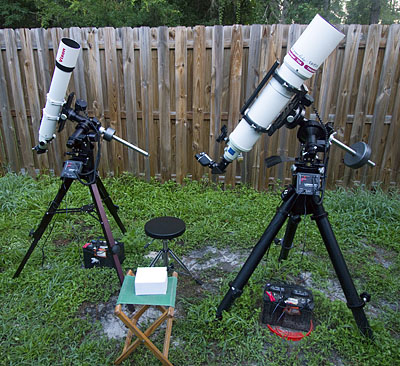 |
Vixen ED100SF (left) and Takahashi TOA-130 (right) on Losmandy GM-8 and G11 mounts, respectively after an early morning session viewing Jupiter. Eyepieces are laid out in the white box for shifting between eyepieces on each telescope. A William Optics binoviewer is mounted on the TOA-130 |
|---|---|
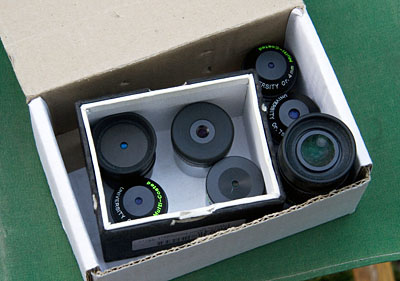 |
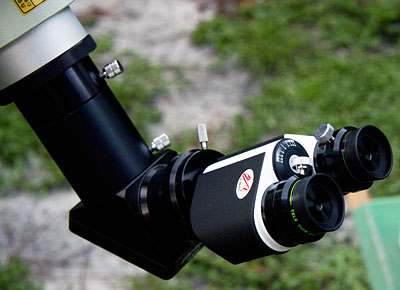 |
Eyepieces laid out in box for comparison viewing |
William Optics Binoviewer on TOA-130 with Televue 8mm Plossl eyepieces. A 1.6X Barlow is mounted on the nosepiece for comparable magnification of planets to the 5mm eyepieces tested. |
Date posted: 31 July 2011, Updated 09 August 2011